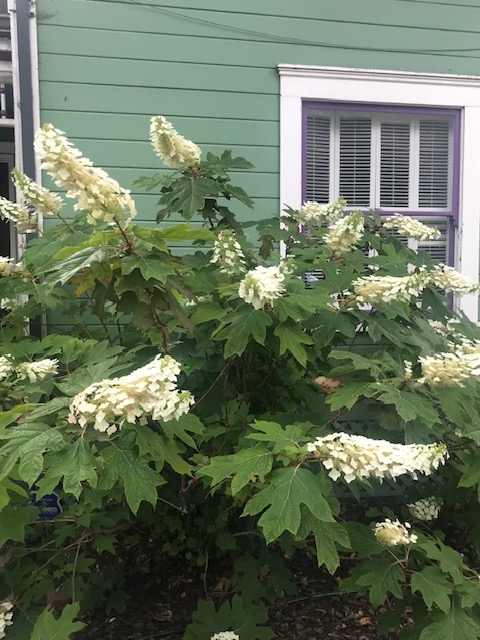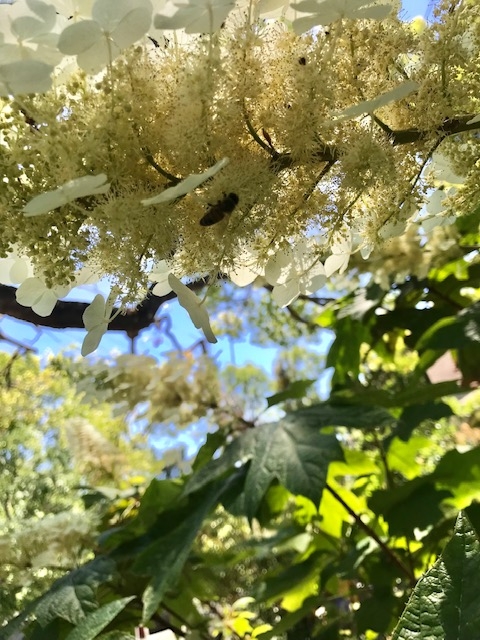Every year I have a different favorite plant. Last year it was brugmansia, the year before that monarda, but this year--which has already had a couple of scorching days--it is the oakleaf hydrangea (Hydrangea quercifolia). I find it appealing because it is dramatic and easy to care for, and it requires very little water.
I'll repeat that: it requires very little water. Being aware of a plant's water needs is our reality and I have accepted it. We all should. Oakleaf hydrangea shows we can live within limits. Anyway, I am too old to emigrate to the north of Scotland, where I understand it still rains.
I first noticed, really noticed, this exuberant flowering plant when I was wandering around the Napa Mill project downtown a few years ago. Among the many lovely plants there, the oakleaf hydrangea was a standout. It was over six feet tall, and it had teardrop-shaped spires of cream-colored florets. They were almost a foot long with a pleasant talcum powder-y scent, and bees were buzzing in the blooms. I rushed off to the nursery and bought one, and it has prospered for several years, despite a couple of pruning misadventures.
The name hydrangea comes from the Greek words for water (hydro) and vessel (angos). It is true that most hydrangeas are real water gluttons, but the oakleaf hydrangea is not. If you look at the leaves of a typical hydrangea, they are quite thin compared to the thicker (water-storing) leaves of the oakleaf varieties. When my other two hydrangeas are drooping, it stands tall.
Unlike other hydrangeas, which mostly originated in Asia, the oakleaf hydrangea is native to southeastern North America. It gets its name from its lobed leaves and its coloring in the fall, similar to oak trees. The leaves turn a dark rosy burgundy and the stems take on a dramatic bronze hue, with a peeling look that adds interest to a winter garden.
The oakleaf hydrangea comes in several varieties. ‘Munchkin' and ‘Pee Wee' are suitable for smaller gardens, as their names indicate. ‘Alice' and ‘Snowflake' are much larger. Because of its size variations, H. quercifolia can be used in all sorts of borders or groupings, as well as a stand-alone plant. It is close to disease free, so it is excellent for mixing with other plants.
I have seen oakleaf hydrangeas planted in full sun, but they like some shade. Half shade and half sun is ideal. Mine gets more sun than it did last year, thanks to the PG&E tree trimming. My two lacecap hydrangeas are badly singed; the oakleaf is perfectly fine.
Oakleaf hydrangeas prefer moist, well-drained soil amended with compost and a dose of organic fertilizer once a year. While they can survive on less than half the water of a regular hydrangea, they do appreciate a good watering in very hot weather.
As for pruning, they don't need much. Two years ago I didn't prune them after the blooms faded, because I wanted to see the transformation into red leaves. Then I pruned them after Christmas.
That was a mistake, as I unwittingly clipped off the buds at the ends of the branches. (Oakleaf hydrangeas flower on old growth.) So, last spring I had a plant with white blooms growing inside the bush, peeping out coquettishly when the wind blew, like a white petticoat. This was not what I wanted.
Last year I didn't prune it at all and was rewarded two months ago with big, fluffy blooms at the ends of the branches. I will prune the flowers soon, as they are turning a light brown. That will allow new buds to form. The oakleaf hydrangea is attractive in all stages, however.
Even though hydrangeas are close to disease free, you should always clean your cutting tools with a solution of bleach when you are done with your chore.
While researching this article, I learned something new: the hydrangea is poisonous. That should not have been a surprise, as many common garden plants are toxic, including my beloved brugmansia. According to the UC Master Gardener Handbook, the leaves and buds contain hydrangin, a "cyanogenic glycoside with the potential to produce cyanide."
The passage ends on this reassuring note: "In the few reported poisonings, the symptoms were limited to nausea, vomiting, and diarrhea. Weakness, light-headedness, and shortness of breath may also occur."
The handbook entry adds that no recent cases of animal poisoning have been found. In fact, deer are known to chomp on the young leaves and buds with no ill effects. Poisoning (which would require eating the plant) is very unusual, but contact dermatitis from hydrangeas is not. Wearing gloves and washing hands after working in the garden is always good practice.
The oakleaf hydrangea is an easy-to-grow shrub that delivers beauty and variety to your yard, as well as being very attractive to bees. Just don't eat it.
Food Growing Forum: Join UC Master Gardeners of Napa County for a free forum on “Integrated Pest Management” on Sunday, July 10, from 3 pm to 4 pm via Zoom. Learn about IPM and what to do in the July food garden. Register to receive the Zoom link at https://ucanr.edu/2022FoodForumJuly
Gardening with the Masters: Join UC Master Gardeners of Napa County and Ole Health on Saturday, July 16, from 10 am to 1 pm at Ole Health South Campus, 300 Hartle Court, Napa, for a workshop on gardening. Children five years old or older, accompanied by an adult, are welcome. Attendance is limited. Register here: https://www.olehealth.org/our-services/community-outreach-resources
Soils Workshop: Join UC Master Gardeners of Napa County for a hands-on workshop on “Soil Rejuvenation and Maintenance” on Saturday, July 30, from 11 a.m. to 1 p.m. at Las Flores Learning Garden, Las Flores Community Center, 4300 Linda Vista Avenue, Napa. Learn how to prepare and care for your soil year-round. Bring gloves and wear gardening attire. Registration required at: http://ucanr.edu/2022LFLGSoilRejuvenation
Got Garden Questions? Contact our Help Desk. The team is working remotely so please submit your questions through our diagnosis form, sending any photos to mastergardeners@countyofnapa.org or leave a detailed message at 707- 253-4143. A Master Gardener will get back to you by phone or email. For more information visit https://napamg.ucanr.edu or find us on Facebook or Instagram, UC Master Gardeners of Napa County.

